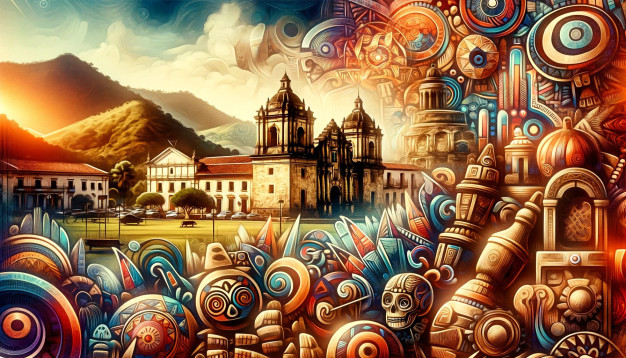History of Costa Rica
Explore Costa Rica's journey from colonial times to its modern eco-tourism prowess.

Pre-Columbian Period
Indigenous Tribes
Before European feet ever shuffled onto Costa Rican soil, a mosaic of indigenous tribes inhabited the lush landscapes. No one tribe dominated, but the Boruca, Chorotega, and Bribris were a few who left an impressive cultural footprint, which you can still witness today in their traditional crafts and languages that refuse to be silenced by time.
Influence of Mesoamerican and South American Cultures
Costa Rica was a cultural crossroads, with the Mayans to the north and the Incas to the south playing tug-of-war for influence. This resulted in a delightful archaeological layer cake, flavored by both Mesoamerican and South American civilizations. The Diquís spheres, anyone? Massive stone balls still mystifying historians and perfectly Instagrammable—if that’s your thing.
Spanish Colonization
Christopher Columbus’ Arrival
In 1502, Christopher Columbus parked his boats on Costa Rica’s Caribbean coast. Naming the place ‘Rich Coast’—because he apparently confused shininess for wealth—he set off a chain of events that would transform the region. Gold eluded the Spaniards here, but the real treasure turned out to be the land and its people.
Settlement and Conquest
The Spanish colonization was more of a slow burn than a wildfire. Indigenous resistance and diseases made it a tough gig for the conquistadors, who found more success with their encomienda system, which sadly exploited the native population under the guise of protection and Christian tutelage.
Colonial Economy and Society
Cash crops like tobacco and cacao were the economic heartthrobs of colonial Costa Rica. Society was a bit of a social jambalaya, with Spanish bureaucrats on top and a mix of mestizos, mulattos, and indigenous folks simmering at the bottom.
Independence
Struggle for Autonomy
Costa Rica shrugged off Spanish rule in 1821 without spilling a drop of blood—a move as peaceful as the country’s modern reputation. A bit of a historical mic drop, really.
Joining the Federal Republic of Central America
Initially, Costa Rica joined the stylishly named Federal Republic of Central America. It was like the United Nations, but with more flags and fewer meetings.
Permanent Independence
The party didn’t last long, though. By 1838, Costa Rica was an independent single ready to mingle on the world stage, setting the tone for its future pacifist stance.
Formation of the Costa Rican Identity
Coffee and Bananas: Economic Drivers
Coffee became the black gold that financed the nation’s glow-up in the 19th century, while bananas added a slippery step to the economic ladder in the 20th century. Together, these two were the Laurel and Hardy of Costa Rica’s agricultural comedy.
Abolition of the Military
In a move that made the world gasp in awe, Costa Rica ditched its military in 1948. The budget for bayonets was reallocated to education and healthcare, which is like swapping your sword for a scalpel and a library card.
Democratic Development
A stable democracy blossomed, proving that you can indeed run a country without needing a bedtime story from a general. Elections became Costa Rica’s favorite national pastime—after soccer, of course.
20th Century Challenges and Progress
Social and Economic Reforms
The mid-1900s was a period of bold social reforms. Universal healthcare and education became the glamorous norm, shining brighter than the neon lights of Vegas—except with more stethoscopes and fewer Elvis impersonators.
Civil War and Its Aftermath
1948 also spiced things up with a civil war—a short but intense affair that left José Figueres Ferrer in charge. He’s the guy who had the lightbulb moment to abolish the military.
Political Stability and Growth
Post-war, Costa Rica was on a roll, with political stability that was the envy of its neighbors. Think of it as the Switzerland of Central America but with better weather and more iguanas.
Modern Costa Rica
Environmental Leadership
Costa Rica is the cool kid in the global fight against climate change, safeguarding its biodiversity like a bouncer at a nature club. Over 25% of the country is protected land, a testament to its commitment to keeping Mother Nature on the VIP list.
Economic Diversification
The economy diversifies like a talented street performer, juggling technology, services, and tourism alongside traditional agriculture. It’s a balancing act worthy of applause and a few thrown coins.
Challenges in the 21st Century
Modern issues like immigration, economic inequality, and sustainability woes keep Costa Rica on its toes. It’s not all rainforest treks and sloth selfies.
Cultural Heritage
Indigenous Influence
Indigenous heritage still adds spice to the cultural stew with languages, crafts, and festivals. It’s like a history lesson, but fun and with better music.
Spanish Legacy
The Spanish left their mark with the language, colonial architecture, and a penchant for fiestas that can make a Tuesday feel like New Year’s Eve.
Modern Costa Rican Culture
Today, Pura Vida isn’t just a phrase; it’s a lifestyle that captures the blissful blend of relaxation and zest for life. It’s the philosophical mojito of Central America.
Conclusion
Costa Rica’s Place in the World Today
In the grand global shindig, Costa Rica stands as a beacon of peace, environmental stewardship, and pura vida vibes. It’s not just a spot on the map; it’s a green thumbprint on the world’s conscience, proving that progress and nature can dance cheek to cheek without stepping on each other’s toes.